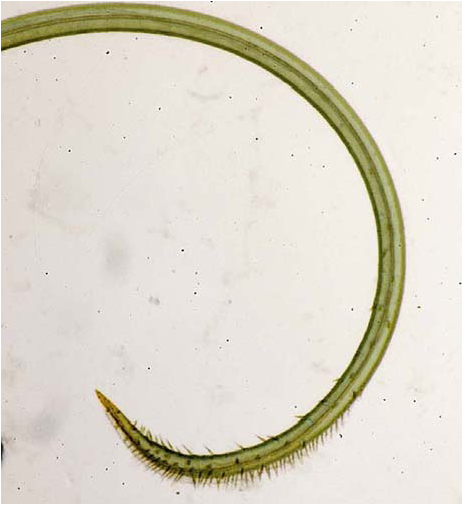On the way to work this morning I was listening to a Skeptics Guide to the Universe podcast, & one of the topics under discussion was vampires. Vampire moths! How cool is that? Vampire bats I know about, & vampire finches, but blood-sucking moths? I had to find out more…
I was surprised to discover that a number of species in the moth genus Calyptra, found throughout southern Europe, eastern Africa and South-East Asia, are known for their habit of sucking on blood (Jaspel et al. 2007). What drew the attention of the SGU team (&, as a result, mine) was the researchers’ suggestion that they were seeing an evolutionary transition occurring.
Like all moths & butterflies, Calyptra moths feed using a proboscis – a long, coiled ‘tongue’ that’s typically used for feeding on nectar & fruit juices (and, in at least one lepidopteran species, on tears). But in Calyptra this proboscis is modified: its end is covered with strong, hard hooks that can pierce the skins of fruits – and the skins of mammals.

From Zaspel et al. proboscis of Calyptra thalictri, showing the tearing hooks at its tip.
Of the 17 or so known species of Calyptra, 8 have been described as vampirising mammals (including, for 5 of those species, humans) in the wild, plus there’s another that’s been shown to suck blood in experimental conditions. Zaspel & her colleagues comment that all of these are regarded as opportunistic blood-suckers, mainly in subtropical areas of Asia. Interestingly, only male moths have been reported to suck blood. (I did wonder about whether these strange insects could possibly be vectors for blood-borne diseases…) The focus of their paper is the first case of blood-feeding in a Far Eastern Russia population of Calyptra thalictri – and of the same behaviour by this population in experimental conditions. Previously Calyptra thalictri was thought to feed only on fruit.
The team collected moths in broadleaf forests in streams & river valleys, & brought them back to their base. Then began the experimental bit (rather reminiscent of the work done to determine mosquitoes as the vector of yellow fever): moths were kept in vials, & a researcher would insert their thumb into the vial & wait to see what happened over the next 10 minutes. There’s a video of the whole thing here on the National Geographic site – I was fascinated by how the moth turns its head from side to side while it’s feeding 🙂 It’s not an enitrely painless process: "The subject observed slight swelling in the area around the wound, & described a feeling of slight stinging pain for 2-3 h following the attack." And only male moths showed any inclination to feed – & not all of them did so, although some were described as grazing the skin & then licking moisture from it.
It seems that the vampiric population of C.thalictri has slightly different appearance from other populations of this species that don’t suck blood. Based on this observation, plus the differences in behaviour, the team suggest that they could be looking at the beginnings of a new species – although obviously this needs a lot more data to confirm it. They intend to do DNA studies of the 2 populations as a first step. They also need to know how common blood-feeding is in natural conditions.(Why only males? It may have something to do with maximising sperm quality, by accessing a source of amino acids or salts when these are in short supply in the normal diet.)
But there is certainly a feasible evolutionary sequence here, from moths that suck juice or nectar, to those that actually pierce the skin of fruits to get at the juice, to those who – opportunistically or otherwise – take blood.
J.M.Zaspel, V.S.Kononenko & P.Z.Goldstein (2007) Another blood feeder? Experimental feeding of a fruit-piercing moth species on human blood in the Primorye Territory of Far Eastern Russia (Lepidoptera: Noctuidae: Calpinae). Journal of Insect Behaviour 20: 437-451. doi 10.1007/s10905-007-9090-3

Suzanne Wells says:
This morning I had a moth bite/ tear a tiny piece of my skin off,, WOW, never knew this was a reality.. I felt a pain on my arm and seeing a moth there I gently moved it off,, I never expected anything nor was I aware I had been proboscised until I looked again due to the pain, and researched the possibility online. It reminded me more of an angry wasps tear I had seen on defenseless baby mice.. anyway for the sake of not allowing the possibility of infection spreading due to pain and reddening I applied a drawing ointment and plaster which offered relief and drew out some gunk. Just checking to see if we had them in N.Z and your page came up. Regards Suzanne.